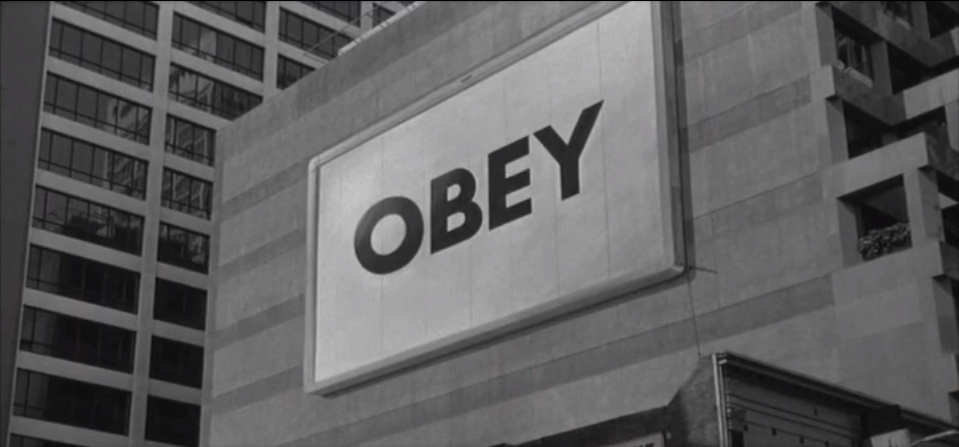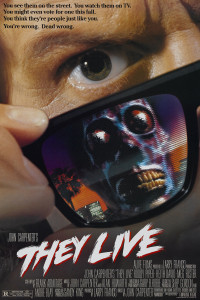 They Live (John Carpenter, 1988, 93 min)
They Live (John Carpenter, 1988, 93 min)
Chazen Museum of Art, Thursday, June 19, 7pm»
Note: I’ve offered a brief appreciation of They Live below, assuming that most have seen the film. In the event that you haven’t, there may be some spoilers below.
UW Cinematheque’s summer slate is packed with both the variety and the quality that we’ve come to expect, but this year’s selection of summer opener threw me for a loop in the best possible way. By some measures, They Live is the consummate John Carpenter film. Carpenter is a genre director who almost always infuses political elements into his scripts, and They Live is more overtly political than any of his previous work. Speaking of genre, Carpenter’s films often work in multiple genres simultaneously, and moviegoers get healthy doses of sci-fi, action, and comedy with this one. Finally, Carpenter’s films demonstrate just how much a score can do with only a few notes of maddeningly repetitive, inexplicably enjoyable synth music. Rest assured, thanks to Alan Howarth and the director himself, They Live is no exception. (Seriously, I’ve had the main theme in my head for days). If it is not the zenith of Carpenter’s career, it is surely a high among the several lows to follow (In the Mouth of Madness excepted).
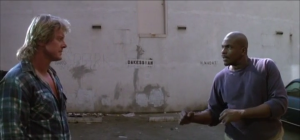 But there’s one thing that anyone who has seen the film will mention whenever They Live comes up in conversation: it has one of the most violent, most unrelenting, and most absurdly hilarious fight scenes in cinema history. Fifty-five minutes into the movie, “Rowdy” Roddy Piper and Keith David—the film’s principal good guys—square off in a back alley. After a good 6 minutes of roughly choreographed “difference-settling,” your list of greatest cinematic fight sequences instantly makes room for this matchup. Having not seen the film in quite a while, what really struck me was not only the fight scene, but just how little action occurs in the first 40 minutes of the movie, and yet how surprisingly smoothly the film still moves.
But there’s one thing that anyone who has seen the film will mention whenever They Live comes up in conversation: it has one of the most violent, most unrelenting, and most absurdly hilarious fight scenes in cinema history. Fifty-five minutes into the movie, “Rowdy” Roddy Piper and Keith David—the film’s principal good guys—square off in a back alley. After a good 6 minutes of roughly choreographed “difference-settling,” your list of greatest cinematic fight sequences instantly makes room for this matchup. Having not seen the film in quite a while, what really struck me was not only the fight scene, but just how little action occurs in the first 40 minutes of the movie, and yet how surprisingly smoothly the film still moves.
I would hazard a guess that if today’s studio executive laid eyes on a script in which the main character spent the first 40 minutes of a 93-minute movie mostly walking around and staring at everything around him, there would be one of two choices: compress the script, or chunk it in the trash. In short, it’s a slow burn. The steadfast, deceptively easy pace of the film’s first half results from Carpenter’s narrative strategy, which has two intertwined elements: 1) an entertaining lack of subtlety when it comes to the film’s politics, and 2) a fascination with “Rowdy” Roddy Piper, less as an actor and more as a screen presence.
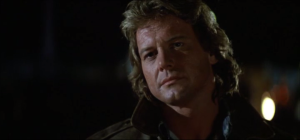
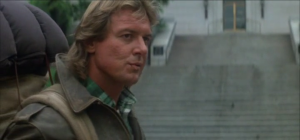 On the political front, Carpenter is anything but delicate in his use of the interstitial radio chatter and television segments, offering a scathing indictment of capitalism and the Reagan years. The mentions of global warming and erosion of the middle class strike a chord with today’s audiences, even if our issues aren’t the carefully crafted results of an alien conspiracy. The subliminal messages are in some cases even more damning, my favorite being what we see when money is viewed through the alien-detecting sunglasses: “THIS IS YOUR GOD,” printed upon the bills. And the use of the sunglasses to detect the aliens, by default, requires a certain amount of that ambulatory voyeurism that Piper executes so well in the first half of the film, which contributes to the easy pace. The inexplicably hypnotic parade of Piper’s silent stares, and the objects of those stares, become our primary method of identifying with the world of the film, whether with all of the tv segments, investigating what is really in the church, or simply walking through the homeless camp. This leads me to the other component of Carpenter’s narrative strategy: Piper himself.
On the political front, Carpenter is anything but delicate in his use of the interstitial radio chatter and television segments, offering a scathing indictment of capitalism and the Reagan years. The mentions of global warming and erosion of the middle class strike a chord with today’s audiences, even if our issues aren’t the carefully crafted results of an alien conspiracy. The subliminal messages are in some cases even more damning, my favorite being what we see when money is viewed through the alien-detecting sunglasses: “THIS IS YOUR GOD,” printed upon the bills. And the use of the sunglasses to detect the aliens, by default, requires a certain amount of that ambulatory voyeurism that Piper executes so well in the first half of the film, which contributes to the easy pace. The inexplicably hypnotic parade of Piper’s silent stares, and the objects of those stares, become our primary method of identifying with the world of the film, whether with all of the tv segments, investigating what is really in the church, or simply walking through the homeless camp. This leads me to the other component of Carpenter’s narrative strategy: Piper himself.
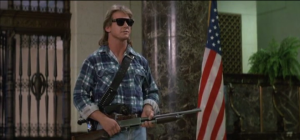 After seeing Piper at Wrestlemania, Carpenter knew he was the lead for this picture. Piper’s nameless character (called Nada in the credits) becomes a far less talky parallel to Kurt Russell’s Jack Burton in the classic Big Trouble in Little China. If you get into the movie, you find it easy to forgive any lag (of which there is little) in the earlier parts of the film in favor of the fascinating nature of Piper’s lumbering bulk, not to mention his action mullet. When Piper starts belting out the wisecracks—which, by the way, seem very much taken from a wrestling script at times—Piper’s screen presence cements itself as vital to how this film works (I was reminded of Soderbergh’s approach with Gina Carano in the austere actioner Haywire). Besides, you know what he’s doing if he’s not chewing bubble gum…
After seeing Piper at Wrestlemania, Carpenter knew he was the lead for this picture. Piper’s nameless character (called Nada in the credits) becomes a far less talky parallel to Kurt Russell’s Jack Burton in the classic Big Trouble in Little China. If you get into the movie, you find it easy to forgive any lag (of which there is little) in the earlier parts of the film in favor of the fascinating nature of Piper’s lumbering bulk, not to mention his action mullet. When Piper starts belting out the wisecracks—which, by the way, seem very much taken from a wrestling script at times—Piper’s screen presence cements itself as vital to how this film works (I was reminded of Soderbergh’s approach with Gina Carano in the austere actioner Haywire). Besides, you know what he’s doing if he’s not chewing bubble gum…
Throw in some marvelous tracking shots during the shootouts, longer takes and coherent staging during that terrific fight scene, more than a few shocks along the way, and maybe Carpenter’s most surprising ending, and you’ve got yourself the makings of a great night at the movies. So, grab your sunglasses and your bubble gum and get yourself down to the Chazen on Thursday night. Even if you have seen this film before, it’s even better seeing it with a crowd. Do yourself a favor and…
